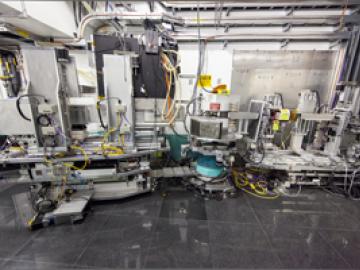Filter News
Area of Research
- (-) Climate and Environmental Systems (4)
- (-) Quantum Condensed Matter (4)
- Advanced Manufacturing (6)
- Biological Systems (6)
- Biology and Soft Matter (4)
- Building Technologies (5)
- Chemical and Engineering Materials (4)
- Chemistry and Physics at Interfaces (11)
- Clean Energy (60)
- Computational Biology (1)
- Computational Chemistry (5)
- Computational Engineering (1)
- Computer Science (1)
- Earth Sciences (1)
- Energy Frontier Research Centers (13)
- Fuel Cycle Science and Technology (1)
- Functional Materials for Energy (14)
- Fusion Energy (1)
- Geographic Information Science and Technology (3)
- Isotope Development and Production (1)
- Materials (70)
- Materials for Computing (7)
- Materials Synthesis from Atoms to Systems (13)
- Materials Under Extremes (11)
- Neutron Data Analysis and Visualization (4)
- Neutron Science (16)
- Nuclear Science and Technology (11)
- Nuclear Systems Technology (1)
- Reactor Technology (1)
- Renewable Energy (1)
- Sensors and Controls (1)
- Supercomputing (35)
- Transportation Systems (5)
News Type
Media Contacts

Advances in ultrathin films have made solar panels and semiconductor devices more efficient and less costly, and researchers at the Department of Energy’s Oak Ridge National Laboratory say they’ve found a way to manufacture the films more easily, too.
Typically the films—used b...

Groundbreaking work at two Department of Energy national laboratories has confirmed plutonium’s magnetism, which scientists have long theorized but have never been able to experimentally observe. The advances that enabled the discovery hold great pro...

depth, population-based approach to identifying such mechanisms for adaptation, and describes a method that could be harnessed for developing more accurate predictive climate change models. For the U.S. Department of...

The Spallation Neutron Source at the Department of Energy’s Oak Ridge National Laboratory broke records for sustained beam power level as well as for integrated energy and target lifetime in the month of June.

The American Conference on Neutron Scattering returned to Knoxville this week, 12 years after its inaugural meeting there in 2002.

Thomas Wilbanks and Benjamin Preston, both of the Climate Change Science Institute (CCSI) at Oak Ridge National Laboratory (ORNL), are among the 309 coordinating lead authors of the Intergovernmental Panel on Climate Change’s (IPCC’s) Working Group II (WG II) report.

Carbon dioxide in the atmosphere may get the lion’s share of attention in climate change discussions, but the biggest repository of carbon is actually underfoot: soils store an estimated 2.5 trillion tons of carbon in the form of organic matter.

Former Energy Secretary Steven Chu mixed his Wigner Distinguished Lecture on Feb . 12 with a description of his current research at Stanford and his outlook on energy policy and climate change.




